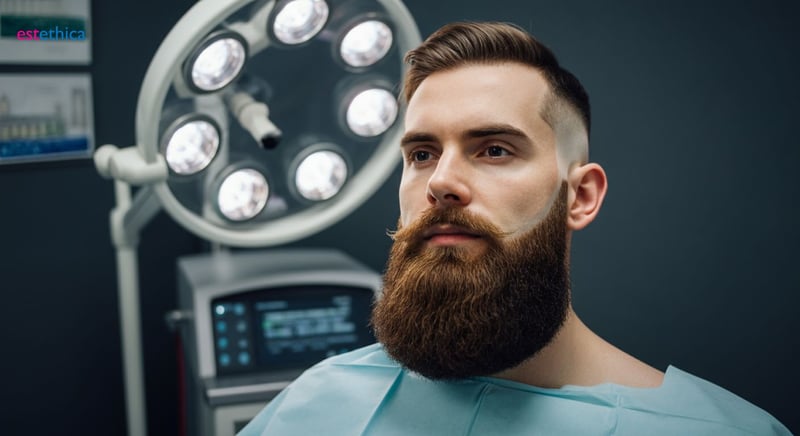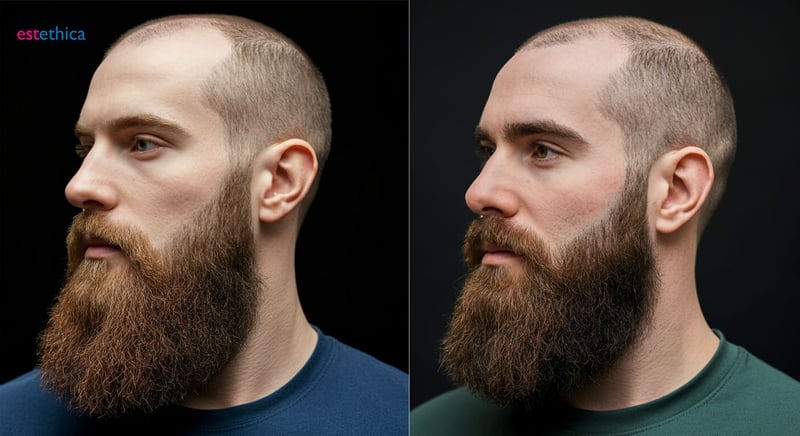Unlock Your Dream Beard: All About Beard Transplants
Achieve a fuller, natural-looking beard with estethica's advanced beard transplant services. Book your consultation today to get started!
Beard transplants have transformed from a niche procedure to a mainstream trend, allowing men to achieve their dream facial hair. As a leading healthcare group that combines ethical practices with state-of-the-art technology, estethica provides top-tier beard transplant services. The demand for beard transplants is on the rise due to the precision and natural results offered by advanced techniques such as FUE (Follicular Unit Extraction) and DHI (Direct Hair Implantation). In this comprehensive guide, we will explore everything you need to know about beard transplants, including the procedures, expected outcomes, and essential aftercare.
Facial Hair Restoration: Is a Beard Transplant Right for You?
Ideal Candidates for Beard Implants
A beard transplant is an excellent option for individuals seeking to enhance their facial hair. If you're experiencing patchy beard growth or desire a denser, more defined beard, this procedure could be the solution. Ideal candidates often include those with genetic predispositions to sparse facial hair. Also, men who've had previous facial scarring may consider this procedure to fill in areas where hair growth is limited. Additionally, individuals who simply want to change the shape or density of their beard can benefit from beard implants.
Key Considerations for Facial Hair Restoration
- Hair Density: Assesses the thickness of the donor area to ensure sufficient grafts for implantation.
- Skin Elasticity: Evaluates how well the skin can accommodate the new hair follicles.
- Overall Health: Ensures the patient is in good health to undergo and recover from the procedure.
Understanding these factors helps determine the suitability for a beard transplant. At estethica, comprehensive evaluations ensure personalized treatment plans. This approach aligns with individual goals for facial hair restoration. For example, a consultation often includes assessing the patient's beard growth pattern and discussing expectations. We maintain a steadfast commitment to patient safety and satisfaction.
The Beard Transplant Procedure Explained
During a beard transplant procedure, hair follicles are meticulously harvested from a donor area. Typically, this area is the back of the scalp. These follicles are then carefully implanted into the beard region to create a natural-looking and fuller beard. The process, often minimally invasive, ensures the newly transplanted hair integrates seamlessly with your existing facial hair. It's essential to consult with specialists who understand the nuances of fue beard transplant or dhi beard transplant techniques. Success stories often highlight the importance of personalized care and attention to detail. estethica prioritizes these elements to ensure optimal results for every patient.
Steps in a Typical Beard Transplant
- Consultation and Planning: Initial assessment to discuss goals and map out the transplant area.
- Extraction: Harvesting hair follicles from the donor site, usually the scalp.
- Implantation: Placing the follicles into the beard area to achieve desired density and pattern.

Beard Implants: Exploring FUE and DHI Techniques
Comparing FUE and DHI for Beard Transplants
Both FUE (Follicular Unit Extraction) and DHI (Direct Hair Implantation) are popular methods for beard implants, each with distinct advantages. FUE involves extracting individual hair follicles from the donor area using a micro-punch technique. These follicles are then implanted into the beard area without making incisions. DHI, on the other hand, uses a specialized Choi implanter pen, allowing for direct implantation of the follicles. This can result in higher graft survival rates, with some studies suggesting up to a 15% improvement in follicle viability compared to traditional methods. Choosing between FUE and DHI often depends on individual patient needs and the specific goals of the facial hair restoration. For instance, FUE might be preferred for larger areas needing coverage, while DHI could be ideal for precise placement and density.
Benefits of FUE and DHI Techniques at estethica
- Precision: Both techniques allow for precise placement of hair follicles, ensuring a natural-looking beard.
- Minimal Scarring: FUE and DHI are minimally invasive, resulting in less scarring compared to traditional transplant methods.
- Faster Recovery: Patients typically experience a quicker recovery time, often returning to normal activities within a few days.
estethica's skilled team excels in both FUE and DHI techniques to deliver optimal results for beard transplant procedures. One example of successful outcomes includes patients achieving a denser beard in areas that were previously sparse. Another advantage is the ability to refine the beard line, creating a more defined and aesthetic appearance. Furthermore, these techniques are valuable for correcting previous botched beard transplant procedures. The choice of technique is tailored to the individual, focusing on achieving the most natural and satisfactory outcome.

Beard Transplant Before and After: What Results Can You Expect?
Navigating the Beard Transplant Journey
Embarking on a beard transplant involves understanding the process before, during, and after the procedure. A key step is the initial consultation, where estethica specialists ensure patients have realistic expectations about the outcome. This involves assessing facial structure and existing hair growth patterns. For example, a client with minimal existing facial hair might expect a significant, though gradual, transformation over several months. An essential part of managing expectations is that initial shedding of transplanted hairs is a normal part of the cycle.
Key Stages of Recovery After a Beard Transplant
- Initial Shedding: Transplanted hairs will fall out within the first few weeks, which is a normal part of the process.
- New Growth Phase: Noticeable hair growth typically begins within three to four months post-procedure.
- Full Results: Complete results can be seen within 12 to 18 months, revealing the final beard density and shape.
The journey doesn't end after the procedure. estethica's dedication to patient satisfaction is evident in numerous success stories. These transformations highlight enhanced confidence and a refreshed appearance among patients. For instance, individuals who had previously struggled with patchy beards often express newfound satisfaction with their fuller, more consistent facial hair. The visual impact of a well-executed beard implant can be life-changing, contributing significantly to personal and professional confidence.

Beyond the Procedure: Essential Beard Transplant Aftercare Tips
Immediate Aftercare for Beard Transplants
Post-transplant care plays a vital role in achieving the best possible outcome after a beard transplant. Following the procedure, it's crucial to keep the transplanted area clean to prevent infection. Gentle cleansing with a mild, specialized shampoo from estethica can help. Hydration is also key. Regular application of a moisturizing cream helps to keep the skin supple and supports healing. Patients should strictly avoid direct sunlight on the treated area. Wearing a hat or using a high-SPF sunscreen can protect the skin. Strenuous activities should be avoided for at least two weeks to allow the transplanted follicles to settle and integrate properly. Examples of activities to avoid include heavy lifting, intense exercise, and any activity that causes excessive sweating. These precautions ensure that the beard implants have the best chance of thriving.
Essential Steps for Optimal Beard Growth
- Gentle Cleansing: Regularly wash the transplanted area with a mild shampoo.
- Moisturize: Keep the skin hydrated to support healing.
- Sun Protection: Avoid direct sunlight to protect the skin.
Beyond these steps, estethica’s aftercare program includes continuous support and guidance. Regular follow-up appointments are essential to monitor progress and address any concerns. The clinic also provides specialized products, such as growth-enhancing serums and follicle-stimulating treatments. These enhance recovery and promote denser, healthier beard growth. Addressing the question, "can I shave after beard transplant?" It's generally recommended to wait at least 10 days before shaving. This prevents dislodging the newly implanted follicles. Additionally, patients should avoid smoking and excessive alcohol consumption. These can impair blood flow and hinder the healing process. With a commitment to comprehensive aftercare, estethica ensures patients achieve the best possible results. The meticulous attention during this phase can significantly impact the long-term success and satisfaction with the facial hair restoration.
Advanced FUE and DHI Techniques for Natural-Looking Beard Transplants
Comprehensive Aftercare Program Ensures Optimal Beard Transplant Outcomes
Frequently Asked Questions
Who is an ideal candidate for a beard transplant?
What are the key differences between FUE and DHI techniques for beard implants?
What results can I realistically expect after a beard transplant?
What essential aftercare tips should I follow after a beard transplant?
How does estethica ensure natural-looking results with a beard transplant?
Achieve your aesthetic goals with world-class expertise and personalized care at estethica!
📞 Discuss Your Needs Today!